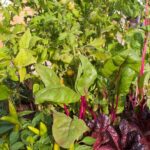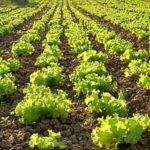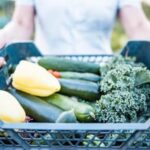Container gardening vegetables is a great way to enjoy fresh produce, even if you’re limited on space. Whether you have a small balcony, patio, or even just a sunny windowsill, you can grow a variety of delicious vegetables in containers right at home.
In this article, we’ll explore everything you need to know about successfully growing vegetables in containers, from choosing the right pots and soil to selecting the best crops and caring for your plants throughout the seasons.
When it comes to container gardening vegetables, choosing the right containers is crucial for the success of your garden. The size, material, and drainage capabilities of your pots can all impact the health and productivity of your vegetable plants. We’ll discuss how to select the best containers for your specific needs and provide tips for optimizing growing conditions.
Once you have your containers sorted out, it’s time to consider which vegetables are best suited for container gardening. Not all crops thrive in pots, but there are many vegetable varieties that are perfectly suited for confined spaces. From vibrant cherry tomatoes to leafy greens and compact herbs, we’ll help you determine which vegetables will flourish in your container garden.
Choosing the Right Containers for Your Vegetable Garden
When it comes to container gardening vegetables, choosing the right containers is crucial for the success of your vegetable garden. The type and size of the container can influence the growth and health of your vegetables. Here are some tips for selecting the best containers for your vegetable garden:
- Material: Choose containers made of durable materials such as plastic, ceramic, wood, or metal. Ensure that the material is sturdy enough to support the weight of the soil and plants.
- Size: Consider the mature size of the vegetables you plan to grow when selecting the size of your containers. A general rule of thumb is to use a container that is at least 12 inches deep and wide enough to accommodate the roots of your vegetables.
- Drainage: Proper drainage is essential for container gardening vegetables. Look for containers with drainage holes at the bottom to prevent waterlogged soil, which can lead to root rot and other problems.
In addition, consider the location and aesthetics when choosing containers for your vegetable garden. Select containers that complement your outdoor space and provide adequate sunlight for your vegetables. Keep in mind that certain vegetables may require larger or more specialized containers based on their specific needs.
With these considerations in mind, choosing suitable containers for your vegetable garden will help create an optimal growing environment for your favorite veggies. Whether you opt for traditional pots, hanging baskets, or window boxes, providing a suitable home for your container gardening vegetables is an essential step towards a bountiful harvest.
Selecting the Best Vegetables for Container Gardening
When it comes to container gardening vegetables, it’s essential to select the right types of vegetables that thrive in confined spaces. Some vegetables are better suited for containers than others, so it’s crucial to choose wisely. Compact and dwarf varieties of vegetables are the best options for container gardening, as they require less space for their roots to grow and develop.
Some great options for container gardening vegetables include tomatoes, peppers, eggplant, lettuce, spinach, radishes, carrots, and herbs such as basil, oregano, and parsley. These plants are well-suited to the limited space provided by containers and can thrive with proper care and maintenance. Choosing the best vegetables for your container garden will ensure a bountiful harvest and a successful gardening experience.
Certain factors should be considered when selecting the best vegetables for container gardening. These factors include the depth of the vegetable’s root system, its adaptability to crowded conditions, its yield potential in small spaces, and its growth habits. By taking these factors into account, you can make informed decisions about which vegetables to plant in your container garden.
In addition to choosing compact varieties of vegetables, it’s important to consider the climate and growing conditions in your area when selecting plants for your container garden. Some vegetables may be more suitable for warmer climates, while others may thrive better in cooler environments. Researching the specific needs of each vegetable will help you determine which ones are best suited for your container garden based on your location and climate.
| Container Gardening Vegetables | Selecting the Best Vegetables |
|---|---|
| Tomatoes | Adaptable & high-yielding |
| Lettuce | Compact & shallow root system |
| Basil | Herb with great adaptability |
Preparing the Soil for Container Gardening
When it comes to preparing the soil for container gardening vegetables, there are a few key considerations to keep in mind. First and foremost, it’s important to choose a high-quality potting mix that is specifically formulated for container gardening. These types of mixes are designed to provide the right balance of nutrients, water retention, and aeration that vegetables need to thrive in a confined space.
In addition to using the right potting mix, it’s also essential to ensure that your containers have proper drainage. Without adequate drainage, excess water can accumulate in the soil, leading to root rot and other issues. To promote good drainage, consider adding a layer of gravel or small rocks to the bottom of your containers before filling them with soil.
Another crucial step in preparing the soil for container gardening vegetables is fertilization. Because container plants have limited access to nutrients in the surrounding ground, it’s important to regularly feed them with a balanced fertilizer. This will help ensure that your vegetables have all the essential nutrients they need to grow healthy and strong.
| Considerations for Preparing Soil | Details |
|---|---|
| Potting Mix | Use a high-quality potting mix specifically formulated for container gardening. |
| Drainage | Ensure proper drainage by adding a layer of gravel or small rocks at the bottom of containers. |
| Fertilization |
Planting and Caring for Your Container Garden Vegetables
When it comes to container gardening vegetables, proper planting and care are essential for a successful harvest. Whether you’re a novice or experienced gardener, there are some key steps to follow in order to ensure your vegetable garden thrives.
1. Choose the right containers: Select containers that are the appropriate size for the type of vegetables you want to grow. Ensure that each container has drainage holes to prevent waterlogging, and consider using different sizes and shapes to create visual interest in your garden.
2. Use quality soil: Good soil is crucial for a healthy container garden. Opt for a high-quality potting mix that is well-draining and nutrient-rich. You can also mix in some compost or organic matter to further boost the soil’s fertility.
3. Plant with care: When planting your vegetables, be mindful of spacing requirements for each type of plant. Follow the guidelines on seed packets or plant tags, as overcrowding can lead to stunted growth and an increased risk of disease. Additionally, be sure to water your newly planted vegetables thoroughly.
Caring for your container garden vegetables involves regular monitoring of moisture levels, feeding with a balanced fertilizer according to the specific needs of each plant, and keeping an eye out for any signs of pests or disease. With attentive care, your vegetable garden will flourish and reward you with a bountiful harvest of fresh, homegrown produce.
Maintaining Your Vegetable Garden Throughout the Seasons
Spring Care
As the weather warms up, it’s important to ensure that your container garden vegetables are getting enough sunlight and water. Spring is also the perfect time to start fertilizing your plants to provide them with the nutrients they need to thrive. Keep an eye out for any signs of pests or diseases as the temperature rises, and take necessary action to prevent any infestations.
Summer Maintenance
During the summer months, it’s crucial to keep a close watch on the moisture levels of your containers. The hot sun can quickly dry out the soil, so regular watering is essential. Additionally, be sure to check for any weeds that may sprout up and remove them promptly to avoid competition for nutrients. Consider adding mulch on top of the soil to help retain moisture and regulate temperatures.
Fall Preparation
As fall approaches, start thinking about how you will transition your vegetable garden into the cooler months. Begin by trimming back any dead or overgrown foliage from your plants. You may also want to consider moving your containers indoors if you live in an area with harsh winters. Fall is also an ideal time for planting cool-season vegetables such as lettuce, spinach, and kale in your containers.
By following these seasonal maintenance tips, you can ensure that your container gardening vegetables continue to thrive throughout the changing seasons, giving you a bountiful harvest year-round.
Common Pests and Diseases in Container Gardening
One of the common challenges in container gardening vegetables is dealing with pests that can damage or destroy your plants. Some of the most common pests you may encounter include aphids, caterpillars, and mites. These tiny creatures can wreak havoc on your vegetables if left unchecked. It’s important to regularly inspect your plants for any signs of pest infestation and take appropriate action to prevent them from spreading.
Preventing Pest Infestations
To prevent pest infestations in your container garden, there are several steps you can take. One effective method is to introduce beneficial insects such as ladybugs or lacewings, which can help keep pest populations under control. Additionally, practicing crop rotation and interplanting different vegetable varieties can also help deter pests from targeting your plants.
Managing Diseases in Container Gardening
In addition to pests, container gardening vegetables can also be susceptible to diseases such as blight, powdery mildew, and root rot. These diseases can be caused by a variety of factors including poor soil drainage, overwatering, or lack of proper air circulation. To prevent diseases from taking hold in your vegetable garden, it’s crucial to practice good gardening hygiene by regularly removing dead or diseased plant material and providing proper spacing between plants.
By being proactive in preventing and managing pests and diseases in your container garden, you’ll be better equipped to ensure the health and vitality of your vegetable plants throughout the growing season. Implementing these strategies will contribute to a successful and bountiful harvest from your container garden.
Harvesting and Enjoying the Fruits of Your Labor
After months of nurturing your container gardening vegetables, it’s finally time to reap the rewards of your hard work. Harvesting your vegetables is an exciting and fulfilling part of container gardening, and it’s important to do so at the right time to ensure the best flavor and quality. When it comes to harvesting, timing is everything.
Before you begin harvesting, it’s essential to know when each vegetable is ready for picking. For example, tomatoes should be picked when they are fully colored and slightly firm to the touch, while carrots can be harvested once they reach the desired size. Be sure to research the specific harvest times for each vegetable in your container garden to avoid picking them too early or too late.
Once your vegetables are ready for harvest, handle them with care to avoid damaging the plants or fruits. Use a sharp pair of pruners or scissors to cut ripe vegetables from the plant without causing unnecessary harm.
Avoid yanking or pulling on the plants, as this can cause damage that may impact future growth and yield. When harvesting leafy greens such as lettuce or kale, simply snip off outer leaves as needed, allowing the inner leaves to continue growing for future harvesting.
After all your hard work tending to your container gardening vegetables, it’s time to enjoy the fruits of your labor. There’s nothing quite like savoring fresh, homegrown produce that you’ve nurtured from seedling all the way to harvest.
Whether you enjoy your vegetables raw in a salad or as part of a delicious cooked dish, there’s a sense of satisfaction that comes from knowing you grew them yourself. So sit back, relax, and savor every bite of those juicy tomatoes, crisp lettuce leaves, and crunchy carrots that you grew with love in your own container garden.
Tips and Tricks for Successful Container Gardening With Vegetables
In conclusion, container gardening vegetables can be a rewarding and enjoyable experience for gardeners of all levels. With the right containers, soil preparation, plant selection, and ongoing care, you can have a bountiful harvest of fresh vegetables right at your fingertips.
It is important to remember that the key to successful container gardening vegetables lies in choosing the right containers and selecting the best vegetables for your specific environment. Whether you have limited space or simply want to add some greenery to your patio or balcony, container gardening can be a convenient and practical way to grow your own produce.
As you continue to maintain and care for your vegetable garden throughout the seasons, it is essential to be mindful of common pests and diseases that can affect your plants. By staying proactive and taking preventative measures, you can minimize the risk of infestations or illnesses that may hinder the growth of your container garden vegetables.
With these tips and tricks in mind for successful container gardening with vegetables, you will be on your way to enjoying a plentiful harvest and savoring the delicious fruits of your labor. So roll up your sleeves, get your hands dirty, and start planting those containers with an array of vibrant and nutritious vegetables.
Frequently Asked Questions
What Are the Best Vegetables for Container Gardening?
The best vegetables for container gardening are those that don’t require a lot of space to grow, such as cherry tomatoes, peppers, lettuce, spinach, and radishes. These vegetables thrive in containers and provide a bountiful harvest.
What Vegetables Grow Well Together in a Container?
Vegetables that grow well together in a container are those that have similar light, water, and soil requirements. For example, you can plant lettuce with radishes or carrots, or beans with cucumbers. It’s important to consider the mature size of the plants and ensure they won’t overcrowd each other.
How Deep Do Containers Need to Be to Grow Vegetables?
The depth of containers needed to grow vegetables depends on the specific vegetable being grown. In general, most vegetables require a container depth of at least 6-12 inches. However, deeper-rooted plants like tomatoes or peppers may need a deeper container of 18 inches or more to allow their roots to develop fully and support their growth.

If you’re looking to get into vegetable gardening, or are just looking for some tips on how to make your current garden better, then you’ve come to the right place! My name is Ethel and I have been gardening for years. In this blog, I’m going to share with you some of my best tips on how to create a successful vegetable garden.





